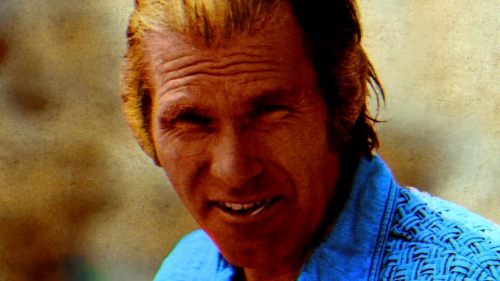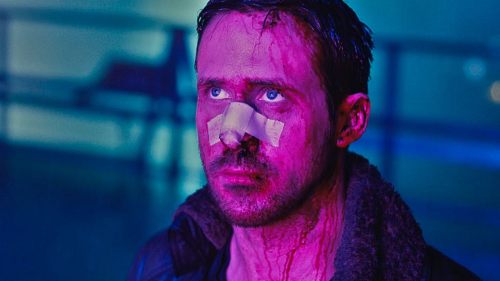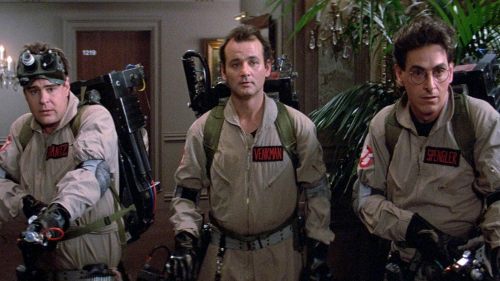Collins’ Crypt: Karloff and Lugosi, Together For The First (And Three Other Times)!
However you feel about the movie itself, or Ken Kirzinger's performance within it, I think we can all agree that the big showdown in Freddy vs. Jason would have been at least a little bit more special if it was Kane Hodder (or any previous Jason, for that matter) in the hockey mask. While they've gone on to appear in other things together, seeing Kane and Robert Englund on-screen together in their most famous roles is the sort of thing modern horror fans never really get to see: iconic star team-ups. Our biggest horror stars: Englund, Hodder, Tony Todd, Doug Bradley, etc. have any number of quick cameos in each others' movies, but rarely anything of much substance. And Bruce Campbell fights himself more often than anyone else that we stand in line to meet at conventions - how has no one made a buddy movie with him and Reggie Bannister, trading quips and romancing women while blowing away monsters?
Contrast that with the previous generation's trio of icons: Christopher Lee, Peter Cushing, and Vincent Price. The three men starred with one another several times, most usually Lee and Cushing thanks to the Hammer films: Cushing's Van Helsing to Lee's Dracula, Lee as the Monster to Cushing's Frankenstein, etc., though there were many others. My favorite might be Horror Express, as the two were partnered instead of at odds, allowing a bit of their real life friendship to show (the characters were friendly rivals, but not antagonistic toward the other). Likewise, Price was friends with both (this clip of him surprising Lee on a talk show can make any old school horror fan get a bit misty-eyed) and appeared with them in films like The Oblong Box (Lee), Madhouse (Cushing), and House of Long Shadows (both of them, plus John Carradine for good measure!). A B-movie can instantly inch into "A" territory when you're seeing two titans of the genre sharing the screen, and it's not just limited to horror - we all know the story of how they basically improvised the "Ty visits Carl" scene in Caddyshack upon realizing that Chevy Chase and Bill Murray didn't have any scenes together.
It's that spirit that makes the Universal Horror Collection Volume 1 set exciting, because it's more specific than what the title suggests. It's not just four Universal movies - it's a quartet of films in which Bela Lugosi and Boris Karloff both appear, presenting four of the eight films they ultimately made together along with the usual bells and whistles (and better transfers, of course). Thanks to their success in the initial Universal Monster films, Uni bosses saw quite a bit of potential in teaming the actors up nearly a decade before they started just combining the monsters instead, and sold the films on their names even as the horror genre's fortunes declined at the box office. I had never seen any of the films before and I wasn't sure I'd get through it all in time for its release (today!), but they were so fun - and yes, short - that it was easy to power through and see what I'd been missing.

The first film on the set is also the first one they made together: The Black Cat, which was released in 1934 and was marketed as being inspired by the same-named Edgar Allan Poe story, but there is next to no real connection to it, but there is a cat in it, at least. It belongs to Karloff's character, an architect named Poelzig who is said to be an old friend of Werdegast (Lugosi), though it's pretty clear early on that the two men are actually enemies, as Karloff is a Satanist who routinely sacrifices women (and keeps their corpses on display for good measure). Turns out they were in the war together and when Werdegast was being held in a prison camp, Poelzig stole his wife and raised their daughter as his own... before marrying her after the wife died. Clearly, Karloff's the villain here, and Lugosi's character is planning to take him down but waiting for the right moment to strike (they actually play chess at one point, likely to make the "putting pieces into place" concept all the more clear to us).
As a pre-code movie it has some more risque material than you'll find in the other films, it more or less sticks to the Hays Code rule of punishing anyone who commits violence, as - spoiler for 85 year old movie ahead - Lugosi manages to defeat his rival (by skinning him! I'd say "Jesus Christ!" but that's also forbidden per the Code) only to get accidentally shot by the film's more traditional hero, a 30ish guy whose wife was Karloff's next target for his rituals. In keeping with the "fun to see them together" theme, the man was played by David Manners, who was in Dracula (as Harker) and The Mummy (Whemple, the archaeologist who digs up Ankh-es-en-amon's tomb), but the real draw is of course the scenes where Lugosi and Karloff square off, trying to get the upper hand over the other. Lugosi's character is paralyzed by a fear of cats, something Karloff uses to his advantage, and as a prisoner of war who lost his family our sympathies are clearly with him, at least until he goes nuts and treats Karloff like the cats he hates so much.
The dynamic is flipped for The Raven, which was probably my personal favorite of the bunch (though Black Cat was probably the better movie by critical standards). Here, Lugosi is a bitter doctor who wants to marry a woman that isn't really interested in him, and sees her father as the only obstacle in his way since he doesn't want her to marry him (for starters, she's already with someone else that he does approve of). So Dr. Lugosi does what you or I would do: turns a patient who came to him for help (that'd be Karloff, a murderer on the run) into a hideous freak via plastic surgery, and tells him that he'll only restore his face if he kills the father. Unlike Black Cat, which let both of their characters reveal their true nature over time, Lugosi's a straight up maniac from almost the first time we see him, and Karloff is introduced as a murderer so we know he's no prize either, allowing them both to cut loose a bit.

And the Poe story is actually included! Not only is Lugosi's character a confessed fan of the writer, but the woman he desires is a dancer performing in a stage production of "The Raven", so we hear a good chunk of it narrated during the performance. As a bonus, he doesn't just rely on Karloff to do his dastardly deeds - he also has a few torture devices, including one directly cribbed from "The Pit and the Pendulum" (which he acknowledges and credits to Poe, of course). In fact he is in the movie much more than Karloff, and was rightfully angry when the studio billed the other man first (as he was for all four of the films on this set, though this is the only one where top billing should have gone to Lugosi), and due to the less-than-stellar makeup appliance on Karloff, he comes out of it looking better to boot. Like Black Cat it's also only an hour long, so it's easy enough to watch them back to back and enjoy seeing them essentially swap roles from one to the other, while feeding off each other's energy to deliver some of their more enjoyable performances.
Unfortunately, it was not a hit at the box office (The Black Cat was Universal's biggest hit of that year, in contrast), and that along with a management change at Universal (and an outright ban on this kind of film in the UK) had them reducing their horror output over the next few years, though they still wanted to stay in business with the two actors. Thus, the next film on the set, The Invisible Ray, is more sci-fi than horror, clearly inspired by the success of The Invisible Man as it's also about a scientist who meddles with the wrong things and turns into a crazed killer as he suffers the effects of his experiment (though he doesn't turn invisible - he glows in the dark!). Lugosi plays one of the scientists who helps along the way; he got second billing but his role is smaller than the other two films, and it honestly feels like the studio throwing him a bone rather than giving him a part worthy of his talents. Plus, as Karloff's character fakes his death halfway through, the two don't get to interact as much as they do in the other two films, which is a bummer.
But at least they DO interact, which is more than you can say for the fourth selection, Black Friday. This is even less of a horror - it's basically a gangster thriller with some mild sci-fi elements, and Lugosi's role is essentially a cameo in a few scenes without Karloff in them. Horror fans will likely be more amused by the film's original title ("Friday the Thirteenth"!) than its content, but it's actually a good pairing with Invisible Ray as both are about a team (scientists in that one, crooks here) being wiped out one by one, with newspaper headlines reminding us of their connection in case we couldn't follow along. They're both OK enough movies, but the two "Poe" ones are the real draw here - these two can be looked at as supplements (though Karloff's glow in the dark effect is kind of cool in its primitive way, I must admit).

Naturally as this is a Scream Factory set, there are plenty of legitimate bonus features as well - all four films have commentary tracks (two apiece for Black Cat and Raven, in fact), a few trailers, vintage recordings of the actors reading the Poe stories, and even some (sadly mute) footage of a contest where the two men seem to have been asked to judge a black cat contest. But the best of the lot is A Good Game, a four part documentary (broken up by film and placed on its respective disc) of the two men's history together, both in these films and in others, such as The Body Snatcher (itself released by Scream Factory not too long ago), dispelling rumors of their animosity toward each other and putting their work in these films within the context of their career as a whole, while also giving us a quick recap of what was happening in the horror genre at the time. If you love the stories of this era (and I do), it's worth putting the discs in one after the other to watch the entire thing as a movie of its own (in fact, combined they run longer than all but one of the films on the set).
It's a shame that Ed Wood (great film that it is otherwise) helped propel the myth that Lugosi hated Karloff, a falsehood that the historians even acknowledge in one of the Good Game segments. The two were never best buds like Cushing and Lee, no, but they respected one another and were professional when they worked together, something they actually quite enjoyed (especially after Lugosi got over his original apprehension at being listed "beneath" Karloff on the posters and such). In the three films that they interact (and the others not present in this set, particularly Son of Frankenstein) it's obvious that whatever "rivalry" they may have had only fueled their performances, and enjoyed it enough to do it again and again (and even become friendly; Lugosi apparently came to the hospital to give the Karloff family a gift when they had their daughter Sara). And it was the positive reception that allowed future horror filmmakers to see the value in doubling their appeal by letting these icons play off each other. Here's hoping we continue to get new horror heroes that will give continuing generations the same kind of thrill.



